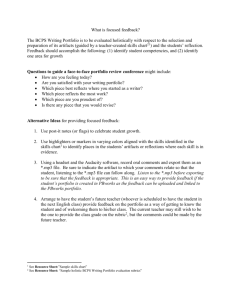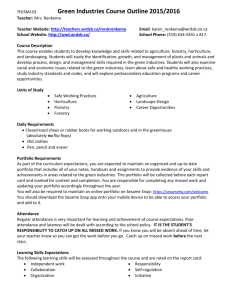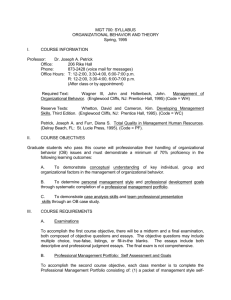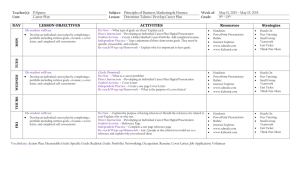Lane Department of Computer Science and Electrical Engineering
advertisement
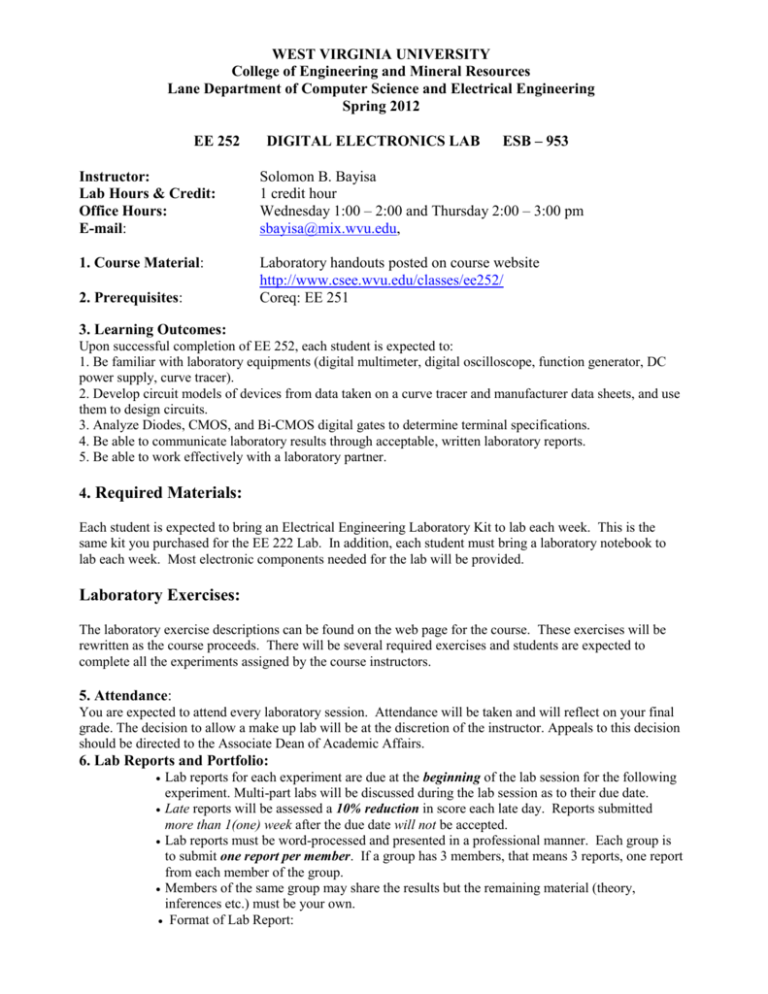
WEST VIRGINIA UNIVERSITY College of Engineering and Mineral Resources Lane Department of Computer Science and Electrical Engineering Spring 2012 EE 252 DIGITAL ELECTRONICS LAB ESB – 953 Instructor: Lab Hours & Credit: Office Hours: E-mail: Solomon B. Bayisa 1 credit hour Wednesday 1:00 – 2:00 and Thursday 2:00 – 3:00 pm sbayisa@mix.wvu.edu, 1. Course Material: Laboratory handouts posted on course website http://www.csee.wvu.edu/classes/ee252/ Coreq: EE 251 2. Prerequisites: 3. Learning Outcomes: Upon successful completion of EE 252, each student is expected to: 1. Be familiar with laboratory equipments (digital multimeter, digital oscilloscope, function generator, DC power supply, curve tracer). 2. Develop circuit models of devices from data taken on a curve tracer and manufacturer data sheets, and use them to design circuits. 3. Analyze Diodes, CMOS, and Bi-CMOS digital gates to determine terminal specifications. 4. Be able to communicate laboratory results through acceptable, written laboratory reports. 5. Be able to work effectively with a laboratory partner. 4. Required Materials: Each student is expected to bring an Electrical Engineering Laboratory Kit to lab each week. This is the same kit you purchased for the EE 222 Lab. In addition, each student must bring a laboratory notebook to lab each week. Most electronic components needed for the lab will be provided. Laboratory Exercises: The laboratory exercise descriptions can be found on the web page for the course. These exercises will be rewritten as the course proceeds. There will be several required exercises and students are expected to complete all the experiments assigned by the course instructors. 5. Attendance: You are expected to attend every laboratory session. Attendance will be taken and will reflect on your final grade. The decision to allow a make up lab will be at the discretion of the instructor. Appeals to this decision should be directed to the Associate Dean of Academic Affairs. 6. Lab Reports and Portfolio: Lab reports for each experiment are due at the beginning of the lab session for the following experiment. Multi-part labs will be discussed during the lab session as to their due date. Late reports will be assessed a 10% reduction in score each late day. Reports submitted more than 1(one) week after the due date will not be accepted. Lab reports must be word-processed and presented in a professional manner. Each group is to submit one report per member. If a group has 3 members, that means 3 reports, one report from each member of the group. Members of the same group may share the results but the remaining material (theory, inferences etc.) must be your own. Format of Lab Report: Title page Experiment No. Title of Experiment Date conducted Your name in bold Group members Class section Objective Equipment used Brief theory Procedure – Brief description of steps involved in the experiment. Results – include code, waveforms, calculations and graphs. Inferences –concluding remarks about the lab and material learnt. Note: Failure to adhere to this format results in deduction of marks. Lab Portfolio: Each student is required to keep his/her own lab Portfolio at the end of the semester. The portfolio must be organized in a 3-ring binder with major sections as follows: o One page summary of what was learned in the Laboratory o Syllabus o Lab notes o Lab handouts All pages must be numbered (with ink), signed and dated. A table of contents should be included on the first page of the portfolio. It should list the title of the lab and the page numbers it covers. All lab handouts, notes, procedures, experimental data, calculations, design ideas etc should be kept in the lab portfolio. Attachments (if any), should be fastened permanently into the notebook. All entries should be made in ink, and mistakes should be crossed out with a single line, not erased or heavily marked out. The portfolio should be a chronological order of all work done. Note: We encourage you to finish experiments during the laboratory schedule. Students in a scheduled period will always have the first priority to the use of the equipment of the laboratory. Final Project Students will be given projects near the end of the last lab exercise. These projects will be demonstrated and a written report shall be submitted. 7. Grading Policy: Lab Reports : 40% Final Design Project : 40% Lab portfolio : 10% Attendance : 10% 8. Grade Assignment: 90 - 100 % 80 - 89 % 70 - 79 % 60 - 69 % A B C D 9. Social Justice Statement: West Virginia University is committed to social justice. I concur with that commitment and expect to foster a nurturing learning environment, based upon open communication, mutual respect, and nondiscrimination. Our University does not discriminate people on the basis of race, color, national origin, sex, age, disability, veteran status, religion or sexual orientation. Any suggestions as how to further such a positive and open environment in this class will be appreciated and given a serious consideration. If you are a person with a disability and anticipate needing any type of accommodation in order to participate in this class, please advise me and make appropriate arrangements with Disability Services (293-6700). If you feel that you are being treated inappropriately or unfairly in any way, please feel free to bring your concerns into my attention. Please be assured that doing so will not prejudice the grading process. In return, I expect you to behave professionally and ethically.







